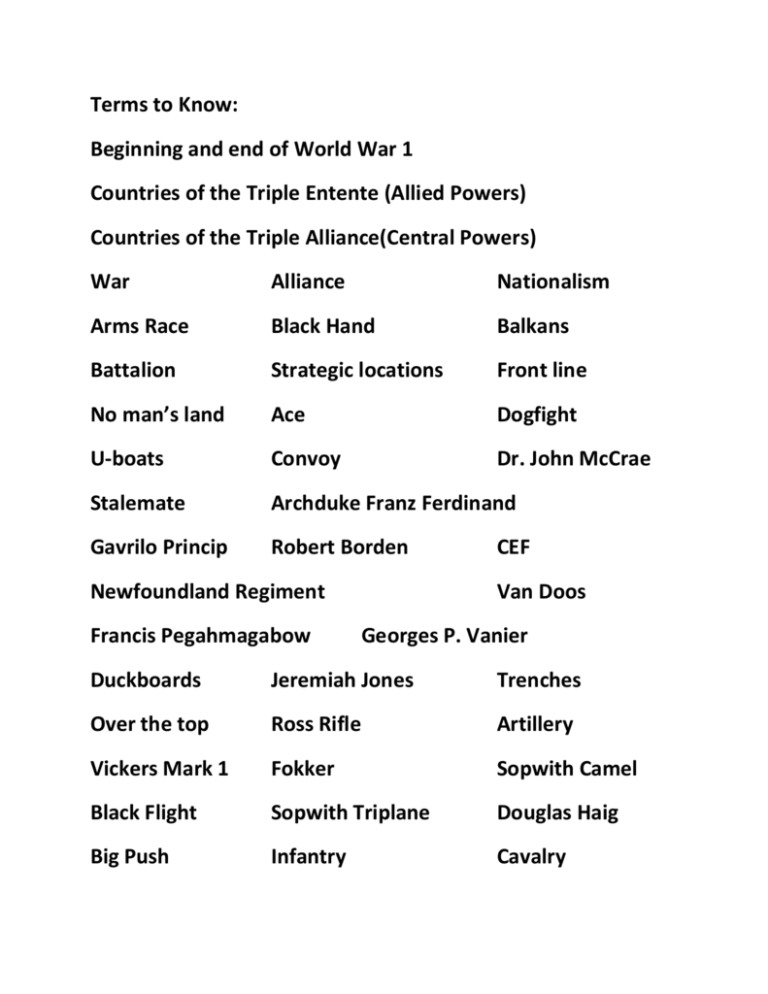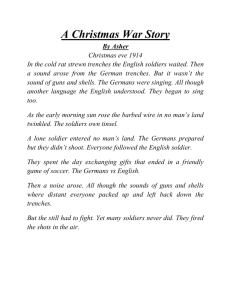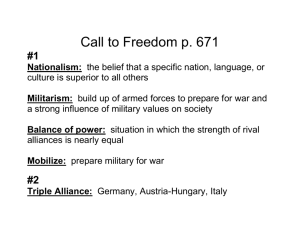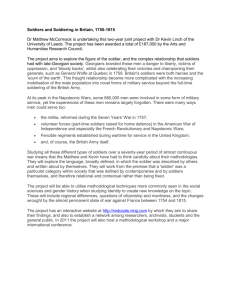terms-to-know-for-ch-15
advertisement

Terms to Know: Beginning and end of World War 1 Countries of the Triple Entente (Allied Powers) Countries of the Triple Alliance(Central Powers) War Alliance Nationalism Arms Race Black Hand Balkans Battalion Strategic locations Front line No man’s land Ace Dogfight U-boats Convoy Dr. John McCrae Stalemate Archduke Franz Ferdinand Gavrilo Princip Robert Borden Newfoundland Regiment Francis Pegahmagabow CEF Van Doos Georges P. Vanier Duckboards Jeremiah Jones Trenches Over the top Ross Rifle Artillery Vickers Mark 1 Fokker Sopwith Camel Black Flight Sopwith Triplane Douglas Haig Big Push Infantry Cavalry Nationalism A strong feeling of pride in your country. Alliance When nations agree to stick together if one member has problems or is attacked. Allied Powers The members of the Triple Entente which included Great Britain, France, and Russia. Central Powers The members of the Triple Alliance which included Germany, Austria-Hungary, and Italy. Arms Race When two countries compete to see who can build up the biggest store of weapons. Balkans A southeastern region of Europe which is home to people of several different backgrounds. Black Hand A group formed in Serbia that wanted to do what it could to keep Austria-Hungary from taking over Serbia. Archduke Franz Ferdinand The heir to the throne of Austria-Hungary who was assassinated by a member of the Black Hand. Gavrilo Princip The 19 year-old student that assassinated Archduke Ferdinand. Robert Borden The Prime Minister of Canada during the First World War. CEF This stands for Canadian Expeditionary Force. The name of Canada's army during the First World War. Newfoundland Regiment The name given to the volunteers from Newfoundland. Battalion A group of about 1000 soldiers and officers. Van Doos The well respected French-Canadian regiment in the First World War. Francis Pegahmagabow A member of the Parry Sound Ojibwa First Nation and one of Canada's "most decorated" soldiers to survive the war. Georges P. Vanier A member of the Van Doos that went on to become Canada's 19th Governor General. Duckboards Floor sections in the trenches made of wooden slats. Jeremiah Jones He became famous for taking on an enemy machine-gun "nest" by himself during the First World War. Strategic location These are areas that let you see what's going on and stop the other side from passing through. Front line The edge of the land taken by an army. No man's land The space between two front lines which was criss-crossed with barbed wire and land mines. Trenches An area dug at the front lines to protect the soldiers. Over the top When soldiers come out of the trenches and cross no man's land to attack the enemy. Ross Rifle A Canadian rifle that was known for jamming when mud got in them. Artillery Large guns such as mortars or howitzers. Vickers Mark I A machine gun used by the British army in the First World War. Stalemate A situation where neither side in a battle can easily advance on the other. Fokker A German fighter plane with a built-in machine gun. Sopwith Camel A fighter plane developed by the allies. Dogfight A fighter plane battle. Ace pilot A pilot that has shot down five enemy planes. Black Flight A group of Canadian fighter pilots that caused the war in the air to turn against the Germans. Sopwith Triplane An allied plane with three sets of wings flown by the Black Flight. Unterseeboot The first small submarines. Convoy A group of supply ships that were protected by many other ships. Douglas Haig The commander of the British and Canadian Forces during the Battle of the Somme. Big Push A straight-on attack. Infantry Foot Soldiers. Cavalry Soldiers on horseback.






